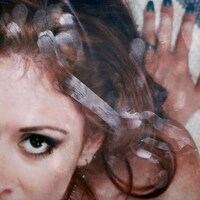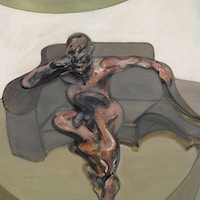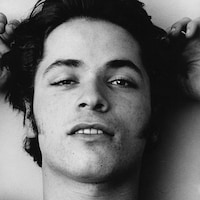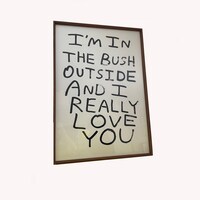‘You enter a space that should be like my mind’: the artist’s debut solo exhibition, Self Dialogues: Hard Food, spans photography, installation, film and audio to delve into her interior world
Behind a mahogany and oak-beaded curtain, light pours through the steeple-like ceiling of central London gallery Alice Black, evoking communion. Fleshy pink paint licks the walls where Jamaica-born, London-based artist Amber Pinkerton’s debut solo exhibition, Self Dialogues: Hard Food, opened earlier this month. The pink imbues the gallery with a cerebral quality as Pinkerton’s voice punctuates its stillness. A monologue unfurls from a set of speakers, so intimate in its content that it feels like reading her diary: “The mind is a locket of secrets. Thinking is a gift of disguise. But if they can hear my thoughts. I am never truly alone.”
Hard Food is the first in a series of intimate and immersive exhibitions that coalesce Pinkerton’s most personal work yet. “There’s an emphasis on feeling in this entire show,” she explains when we meet at her studio in east London ahead of the launch. “You enter a space that should be like my mind.” Hard Food borrows its name from the traditional Jamaican dish of boiled ground provisions: yams, green bananas, pumpkin, potatoes. The double meaning here is that we’re tasting something difficult to swallow. Traversing feelings of detachment and loneliness while unravelling notions of family, love, and migration, Hard Food is a degustation of Pinkerton’s innermost thoughts. Now, at 26, she invites us to chew these over, and, in turn, liberates herself.
Six analogue TV screens are perched on plinths at the back of the gallery, skipping through dream-like fragments from a six-minute film (“Hard Food”) accompanying Pinkerton’s diaristic spoken monologue. Adjacent to these, self-portraiture cyanotypes soaked with tea feature what appears to be a dancing Pinkerton (“Untitled Self Portrait”), the camera shutter release cable like an umbilical cord aiding a rebirth.
“Exploring myself in this honest way feels like biting a forbidden fruit” – Amber Pinkerton
There are biblical connotations to “Eve” – a framed film still of a woman eating a piece of fruit, her expression indiscernible but her gaze searing. “I think exploring myself in this honest way feels like biting a forbidden fruit,” Pinkerton says. Deity-like, Eve hangs higher than any other work in the gallery. “She’s a goddess,” Pinkerton continues, “a scarred yet resilient entity coming out at the other end of her own dark matter.” Here, Eve represents a transition from one state of mind to another as Pinkerton has risen above her hardships. Each work is a fragment of the artist, an expression of the plurality of an individual; a multitude of selves existing as a whole. “It feels like Eve is looking down and around at her old corpse or shed skin,” Pinkerton notes. Akin to the myth of Ouroboros, it’s an act that feels baptismal, not funereal.
“Protector” is a diptych of Eve with a fruit tree and a single tea-toned cyanotype of the dancing Pinkerton. “Throughout the ugly and the beautiful, I always have this sometimes comfortable and uncomfortable feeling that something spiritual is present, watching me,” Pinkerton explains. “Scale came into play as a massive face overlooking a small figure. Mentally, I saw myself this way, like a vessel with an absent soul, but there was also something bigger to cushion me.”
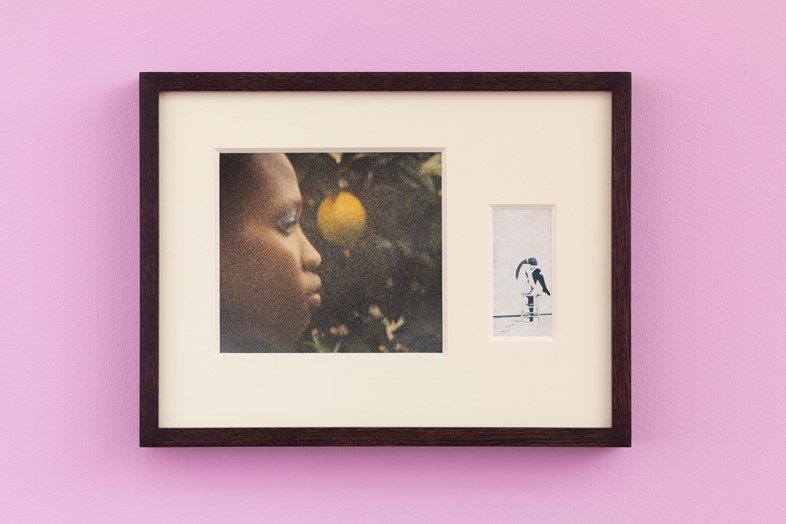
“Heaven and Hell”, a triptych of a flower, a self-portrait, and a girl floating in water, embodies flux. “It’s an abstract work made through channelling emotion,” begins Pinkerton. “But I wanted it to emulate these frequent feelings of high and low, contradiction, polarities, fluctuation.” While many of the works titles are simply ‘untitled’, signalling ambiguity, Pinkerton adds: “I liked keeping a few of the titles reverent in a biblical sense because it felt like a third entity had seen it all.”
Scattered across the two remaining walls of the gallery, photographs of a girl in a blue two-piece, masked by a white tulle veil stretched out of shot, like someone, or something, is holding her back, stalks through darkness. Her vision is partially obscured but her stance is determined; she’s walking towards the light. On one of these walls, a poem (“Self Dialogues”) ruminates on this tug-o-war between selves, encapsulating the visuals in written form.
In the centre of the exhibition is “the baby eggs”, an antique pink jewellery box cradling an iPad with a set of headphones where visitors can experience an extended 12-minute version of Pinkerton’s monologues, each made in collaboration with musician and friend Kwaku Konadu. The audio is presented alongside visuals that appear, overwhelm, and disappear like the thoughts of a chaotic mind. “It gives even more insight into my life and memories,” Pinkerton says. “It’s (about) trying to connect you to me as much as possible.”
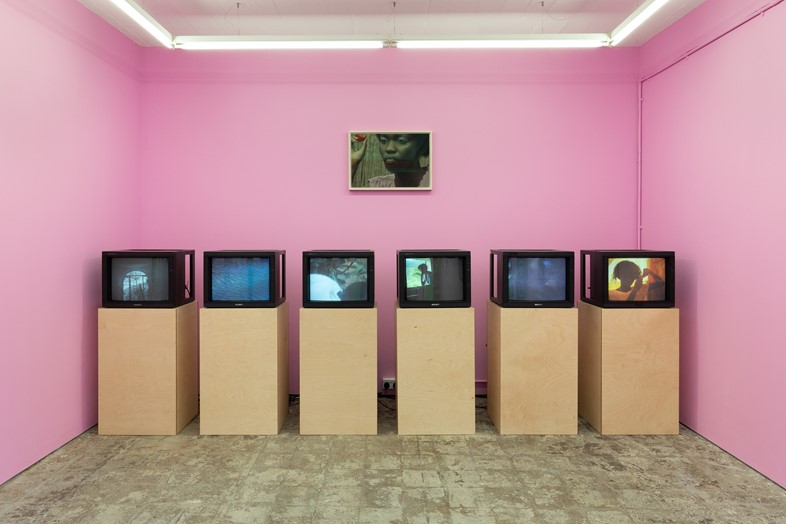
Born in Kingston, Jamaica, Pinkerton moved to London to study for a Bachelor in Practical Filmmaking at the Met Film School, although she dropped out a year later to pursue photography. “My interest and love for photography always outweighed film,” she explains. “I found film too silent and long-winded for my active persona.” From her rented room in Ealing Broadway, west London, it dawned on her how far from home she was, not just in distance but culturally too. “Everything was more fragmented (in the UK), and people were stereotyped and categorised by culture, speech, class,” Pinkerton says. “It was revealing to see how I was stereotyped because it was so offset from the truth of my background. My self-awareness skyrocketed. It made me livid.” The camera became a conduit to channel her rage into empowerment. “It was an isolating and intrapersonal experience,” Pinkerton says. “The art was therapeutic. That was my shouting, my outlet of expression. My anger.”
Hard Food presents a clear break from the fashion photography for Dazed, Vanity Fair, Re-Edition magazine, and clients like Gucci, Miu Miu, and Moncler that have solidified her name in the industry. In 2019, Pinkerton signed as a photographer with the agency Lalaland Artists when she was just 22. That same year she enrolled in a Bachelor of Photography at the University of Westminster, which she will graduate from with first class honours next month. “I always thought I didn’t need to go to school, but at some point, I was still not feeling artistically fulfilled enough,” Pinkerton recalls. “I’d gotten to this point (in my career) at such a young age, but I felt there was more to learn, more ways to develop as an artist. It was honestly the best decision I’ve ever made.”
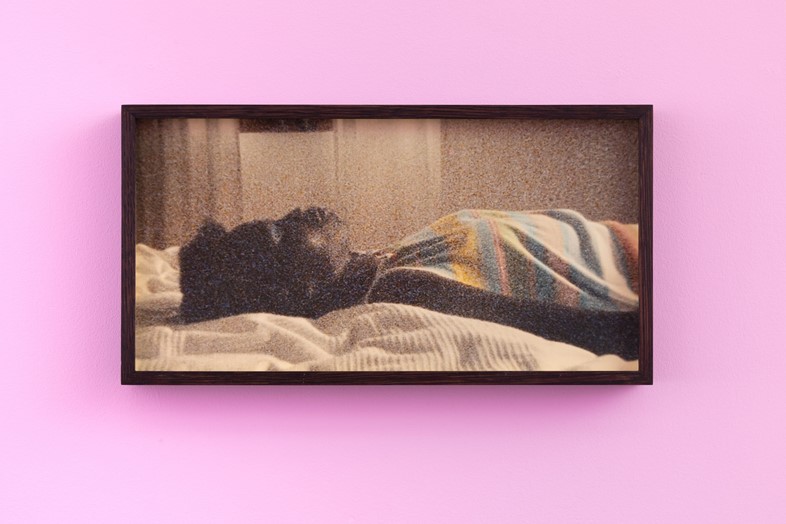
Pinkerton’s a-ha moment came when she took an alternative processes workshop hosted by the school’s fine art department. “I was always going to the fine art department after that,” she laughs. “(A cyanotype is) very painterly, it makes me feel more connected as an artist. It’s like putting some ingrained stamp of myself on it. Maybe, subconsciously, it’s self-preservation.” The works in Hard Food are framed in mahogany, a solid and stable material marked for its beauty and durability. Historically, the wood was one of Jamaica’s biggest exports, lining the pockets of the British colonial powers while exploiting Jamaica’s resources and labour. “I like connecting to materials through texture and I find it interesting how mediums intersect and the different meanings they can bring out,” she explains. “It’s an intentional act that sees Pinkerton begin to explore the photograph as object, while providing a stark reminder of the historical context that frames her experiences in the UK.
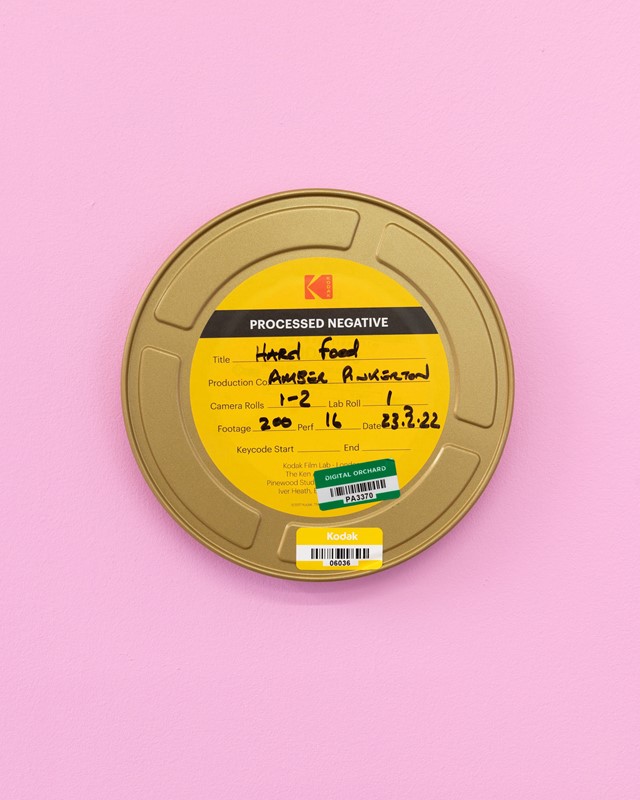
Shifting into a fine art practice has gifted her the patience that remains taboo in the fast-paced fashion world, and, in turn, offered creative respite. “It taught me to work at a different pace that I used to think wasn’t possible,” she reveals. “My course tutor (Eugénie Shinkle) said that I work in fashion so much at a commercial level to the point where I’m overthinking everything. She was like, ‘Why are you showing me this 30-page treatment? Just do it.’” Pinkerton began to cut loose the ways she had been conditioned to work – instead using intuition to guide her. “I was trying to express all these things differently without thinking too much: working from feeling, instinct or where my physical body leaves me with the work rather than thinking about meaning and how exactly it will look. Just seeing where it ends up.”
Hard Food is the first step in an ongoing journey that Pinkerton has a clear vision of, admitting she’s already planning the remaining iterations collectively titled Self Dialogues. A portrait of a woman wearing a white crocheted veil like a bride, her bare skin painted with red love hearts, (“preservation of its soil, albeit stifles its seeds”) is notably the only work created in a public space. Pinkerton’s gallerist Alice Black notes that it’s a deposit for Pinkerton’s next show, which will examine love and desire. “(Hard Food) is an introduction, a skim on me, in an intrapersonal way,” Pinkerton explains. “The other (shows) will go into more external topics.” Despite the interiority that Hard Food is characterised by, visitors will feel a kinship, and, Pinkerton hopes, a sense of catharsis. “I just want everyone to feel something. I even recommend people go alone to be able to take it in and feel it,” she says. “When it’s just you and the work, it does something to you.”
Amber PInkerton’s Self Dialogues: Hard Food is running at the Alice Black gallery until November 11, 2024.
Join Dazed Club and be part of our world! You get exclusive access to events, parties, festivals and our editors, as well as a free subscription to Dazed for a year. Join for £5/month today.







